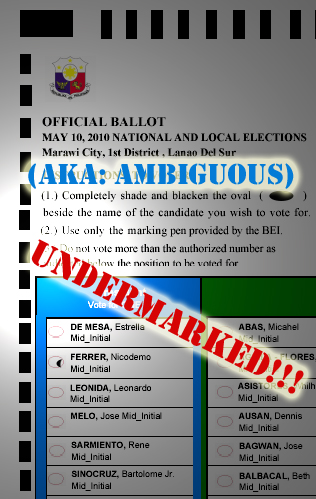For some reason, I felt the need to write about null votes. Again.
The concept of the “null vote” came about as part of the explanation why apparently more people voted for President than voted for Vice President.
There are two basic explanations for the existence of null votes.
 First, the votes of people who shaded in more than one candidate for VP were considered stray by the PCOS, hence not counted. This was precisely what the voter education mantra “DO NOT OVERVOTE!” tried to head off. Technically, when a position is overvoted, such as when the position of VP shows two shaded or more shaded ovals instead of just one, there is officially considered no vote for that position. The reason is simple: the PCOS just can’t tell which of the shaded ovals should be counted. It, therefore, cannot make an arbitrary decision as to which candidate should receive the vote.
First, the votes of people who shaded in more than one candidate for VP were considered stray by the PCOS, hence not counted. This was precisely what the voter education mantra “DO NOT OVERVOTE!” tried to head off. Technically, when a position is overvoted, such as when the position of VP shows two shaded or more shaded ovals instead of just one, there is officially considered no vote for that position. The reason is simple: the PCOS just can’t tell which of the shaded ovals should be counted. It, therefore, cannot make an arbitrary decision as to which candidate should receive the vote.
And second, the votes of people who simply chose NOT to vote have also been called null votes.
 Now, if you wanted to use the null votes as a basis for some sort of protest – nuninuninuninuni – the first thing you’d have to do is to prove that the null votes do exist. F’rinstance, you would have to prove the number of people who actually overvoted. Of course the same goes for the people who didn’t vote at all – you have to establish their numbers as well.
Now, if you wanted to use the null votes as a basis for some sort of protest – nuninuninuninuni – the first thing you’d have to do is to prove that the null votes do exist. F’rinstance, you would have to prove the number of people who actually overvoted. Of course the same goes for the people who didn’t vote at all – you have to establish their numbers as well.
Second step would be to prove that the null votes should go to you. That’s what’s got me scratching my head.
How do you prove that an overvoted ballot should be counted for you? The only person you could probably ask is the voter … but the voter is long gone. Once the ballot is inserted into the box, it becomes a generic vote indistinguishable from all other ballots in the box. You could try to ask the ovals, but they probably won’t talk.
So how do you do it? If for nothing else, a protest along these lines would be educational for showing how you can divine voter intent from two or more shaded ovals.
As for the blank votes – wow. I don’t think anyone will even try to prove that abstentions actually wanted to vote for one candidate or another.
 But hark! There is actually a third category of null votes being proposed: those votes that were visible on the ballot but were NOT ‘recognized’ by the PCOS.
But hark! There is actually a third category of null votes being proposed: those votes that were visible on the ballot but were NOT ‘recognized’ by the PCOS.
In order for this category to exist, there should be instances where the ballot does show a mark but the PCOS count doesn’t reflect the presence of that mark. This is problematic because PCOS machines spit out ambiguous marks. Which means that if there is an under-shaded oval anywhere on the ballot, the PCOS machine ejects the ballot and gives the voter a chance to fix the error. So it is highly unlikely that there will be any ballots in the boxes, that have marks on them which were unread by the PCOS.
In any case, even in a recount, the ballots will all have to be appreciated according to the rudimentary rules of appreciation applied by the PCOS. This means that there is no room for human discretion in the recount process. If the machine refuses to read a mark, then the mark will not be counted for anyone. This is the same rule used by the Random Manual Audit, and there is no reason to change it.
In conclusion, null votes do not really exist. The term itself merely describes the voting potential of the electorate – if you say there are three million null votes, what you’re really saying is that there could have been 3 million more votes than were actually recorded. “Could’ve beens,” unfortunately, do not a winner make; anymore than null votes can change the outcome of the 2010 Automated National and Local Elections.
[nggallery id=1]
